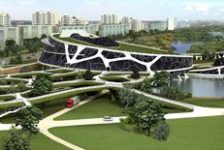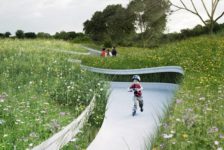Nature possesses the ability to adjust and morph to the ever changing environment. We have managed to present Mother Nature with a few road blocks, but nature has found ways to progress past the wounds that we have made. Only in recent years have people tried to reverse the effects we have had on our environment. It is in these attempts at solving human problems that bring about the concept of biomimicry. More after the jump…
What (the heck) is biomimicry?
“Biomimicry or biomimetics is the examination of nature, its models, systems, processes, and elements to emulate or take inspiration from in order to solve human problems. The term biomimicry and biomimetics come from the Greek words bios, meaning life, and mimesis, meaning to imitate.” In simpler terms, biomimicry is the conscious emulation of nature’s genius.
What can nature teach us?
A lot. Here are some examples of ways nature has provided solutions to human problems:
- Natural Forms: Look at a nautilus hemishell. It shows the camerae in a logarithmic spiral. That form has been a significant inspiration for some of the greatest inventors and scientists. The spiral was first described by Descartes and later investigated by Bernoulli who is best known for his probability theory to games of chance.
- Swarm Theory: Also known as swarm intelligence (SI) can be identified in nature through the movement of a school of fish for example. The theory states it as “the collective behavior of decentralized, self-organized systems, natural or artificial.” The concept is used in work on artificial intelligence. So what we see today applied in robotics and A.I. is a function of the natural occurrence of animals, organisms moving together in schools of fish, herds of animals, and colonies of ants.
- Learning How to Heal Ourselves: One-quarter of all modern medicines are derived directly from plants, and there are hundreds of thousands of other plant species yet to examine, each with dozens of unique chemical compounds that could prove of medicinal value. If one wanted to discover more valuable medicines, where would one start looking? It could take millions of years, literally, to sort through this enormous variety of plants and plant compounds to find ones with medicinal value. Fortunately, this is exactly what researchers have discovered that chimpanzees (Pan spp.) have already done, over millions of years of evolutionary time. By observing how chimps and other species cope with illness, researchers have acquired leads on plants with promising medical applications to human health. Trees from the Vernonia genus, for example, which chimpanzees regularly seek out when ill, have been found to contain chemical compounds that show promise in treating parasites such as pinworm, hookworm, and giardia in humans.
How has biomimicry been implemented in the built environment?
The implementation of biomimicry can be seen and used in a myriad of forms, but the most pronounced of them is architecture and product/industrial design. This is not only a daily experience, but a minute to minute experience. We find ourselves coming in contact with the built environment (the spaces and places we live and move through) and the things/objects we constantly use like the computer, cell phone, touthbrush, car, and so on.
In regards to architecture and the built environment, the forms we traditionally see in modern contemporary architecture are more revealing of nature’s various forms. The works of Frank Gehry and Santiago Calatrava are perfect examples of architecture that use elements derived from nature to inform design and function. Here are four examples below:
1. Milwaukee Art Museum – Calatrava
2. TGV Exupery Train Station, Lyon – Calatrava
3. Experience Music Project, Seattle – Frank Gehry
4. Disney Concert Hall, Los Angeles – Frank Gehry
How can we and how have we already applied biomimicry to landscape architecture?
Biomimicry introduces the pre-existing natural processes, as implemented to physical items and places that cause daily problems. One could say the fluctuation in global temperatures is a problem today and will continue to be if humans don’t change their ways. As a means to reduce this problem, we have brought the integration of the landscape into the urban spaces of our city’s. This has been a more recent phenomenon and would include green roofs, which help reduce the heat island effect and ultimately the process of our planet’s warming. Introducing the landscape to concrete jungles and architecture is an example of nature’s genius put to use.
After the events of Superstorm Sandy and other natural disasters, biomimicry has played a major role in city planning and design in waterfront locations. A New York Times article showcases the numerous ways that biomimicry is being used in architecture, urban design, and landscape architecture.
Life creates conditions conducive to life. We thank you Mother Nature for toughing it out.
What examples of biomimicry have you seen in landscape architecture? How might we push further the concept of biomimicry in the profession?
Thanks for reading!

Sources
Published in Blog
















